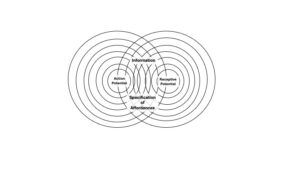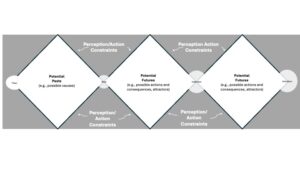What must be admitted is that the definite images of traditional psychology form but the very smallest part of our minds as they actually live. The traditional psychology talks like one who should say a river consists of nothing but pailsful, spoonsful, quartpotsful, barrelsful and other moulded forms of water. Even were the pails and the pots all actually standing in the stream, still between them the free water would continue to flow. It is just this free water of consciousness that psychologists resolutely overlook. Every definite image in the mind is steeped and dyed in the free water that flows around it. With it goes the sense of its relations, near and remote, the dying echo of whence it came to us, the dawning sense of whither it is to lead. The significance, the value, of the image is all in this hallo or penumbra that surrounds and escorts it, or rather that is fused into one with it and has become bone of its bone and flesh of its flesh; leaving it, it is true, an image of the same thing it was before, but making it an image of that thing newly taken and freshly understood. William James (1890, p. 255)
When talking about cognitive experiences people often refer to a sense of 'flow.' This concept does not fit easily into conventional cause-effect narratives based on billiard ball collisions (or string of dominos) metaphors. It suggests the need for a new narrative. I wonder whether it would be possible to follow the lead of physics and consider the possibility of a new narrative where instead of talking about cause - we talk about constraints; and instead of talking about effects - we talk about possibilities.
The physicist, John Wheeler describes the motivation that led physicist to adopt a field narrative:
It is to Aristotle, working in the fourth century B.C., that we owe the popular maxim that ‘nature abhors a vacuum’. It is more accurate to say that people abhor a vacuum. Newton called it an absurdity. Scientists ever since have developed our picture of nature in terms of what I may call ‘local action’, to distinguish it from ‘action at a distance’. The idea of local action rests on the existence of ‘fields’ that transmit action from one place to another. The Sun, for instance, can be said to create a gravitational field, which spreads outward through space, its intensity diminishing as the inverse square of the distance from the Sun. Earth ‘feels’ this gravitational field locally – right where Earth is – and reacts to it by accelerating toward the Sun. The Sun, according to this description, sends its attractive message to Earth via a field rather than reaching out to influence Earth at a distance through empty space. Earth doesn’t have to ‘know’ that there is a sun out there, 93 million miles distant. It only ‘knows’ that there is a gravitational field at its own location. The field, although nearly as ethereal as the ether itself, can be said to have physical reality. It occupies space. It contains energy. Its presence eliminates a true vacuum. We must then be content to define the vacuum of everyday discourse as a region free of matter, but not free of field.
Also Richard Feynman explains the power of the field construct for tracking dynanic relations that extend over space and time:
It [the field construct] would be trivial, just another way of writing the same thing, if the laws of force were simple, but the laws of force are so complicated that it turns out that fields have a reality that is almost independent of the objects which create them. One can do something like shake a charge and produce an effect, a field, at a distance; if one then stops moving the charge, the field keeps track of all the past, because the interaction between two particles is not instantaneous. It is desirable to have some way to remember what happened previously. If the force upon some charge depends upon where another charge was yesterday, which it does, then we need machinery to keep track of what went on yesterday, and that is the character of a field. So when the forces get more complicated, the field becomes more and more real, and this technique becomes less and less of an artificial separation.
Would it be useful to frame the coupling of perception and action in terms of fields of constraint - and to consider how the constraints on information (e.g., Gibson's optical flow fields) specify the possibilities for action (e.g., the safe field of travel) [see Gibson and Crooks,1938]?

Would it be useful to think about event trajectories in terms of fields of possibilities analogous to Minkowski's light cones? However, in thinking of the possibilities for a cognitive system one must consider both the constraints going forward from the present AND the constrains extending backward from a goal or ends - in order to show the possible paths (or means) to an ends. Thus, an event might look something like this, where the constraints on perception and action limit the paths from where you are (now) to where you are striving to reach (intention).

What do you think? What would a field theory of cognition look like? Is it possible for cognitive science to escape from classical Newtonian narratives and to follow physics into a dynamic world that flows? Would it be a step forward?
For a deeper dive into this see: Flach, Dekker, & Stappers (2007). Playing twenty questions with nature (the surprise version): reflection on the dynamics of experience. Theoretical Issues in Ergonomics Science, 9:2, 125-154.

I love the idea, and would very much like to see the expanded version with everything it would imply.
I think it does resonate well with the performance variability notion in Hollnagel (and others) theories in cognitive systems engineering.
Johan - if you are interested check out our book "A Meaning Processing Approach to Cognition" published by Routledge (2020) in the resources for Ecological Psychology Series.
Is the middle diamond in the picture potential present? It has potential future twice. Typo?
The diagram was intended to look two steps into the future - note that this is a potential endless strings of diamonds that reflects changing intention from birth to death.